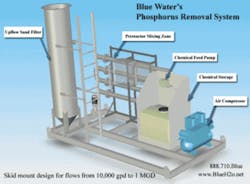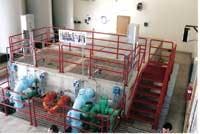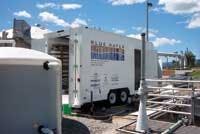New System Optimizes Sand Filter Phosphorus Removal
The Hayden Wastewater Research Facility (HWRF) is a full-scale demonstration and research facility for Blue Water Technologies’ phosphorus removal process, Blue Pro. The mission of HWRF is to showcase phosphorus removal performance and to develop future advanced water treatment processes. In recent testing of the Blue Pro process configured in series, phosphorus concentrations were lowered to non-detect.
With increasing loading in many parts of the US, limits for phosphorus are being lowered for dischargers across the nation. In some locations with particularly sensitive receiving waters, phosphorus permit limits are being set at very low levels, such as 0.050 mg/L or less. Total Maximum Daily Load (TMDL) allocations are being reviewed for many watersheds with special attention on phosphorus, followed by new phosphorus permits through the National Pollutant Discharge Elimination System (NPDES) program.
The research facility was funded by private investment; no grant dollars were used for the construction. In a public-private partnership, the facility was constructed on the grounds of the Hayden Area Wastewater Treatment Plant in Hayden, Idaho. The plant provides wastewater treatment for the local community, allowing research at HWRF to be conducted on actual municipal secondary effluent.
Construction of the research facility was completed in April 2005. HWRF receives secondary effluent from the Hayden plant prior to chlorine addition. HWRF features pre-reactors, a chemical feed system, sand filters ranging from 3 to 50 square feet, and a state-of-the-art process monitoring and control system. The Blue PRO process and other research projects may be run in a parallel or series configuration at many different scales.
The patent-pending Blue PRO technology dynamically combines co-precipitation and sorption, with the goal of providing higher efficiency removal than traditional chemical or biological processes. While the process uses moving bed sand filters, it can achieve removal efficiencies not seen before with this type of filtration.
Testing with the Blue PRO process has been ongoing since the facility was commissioned in May 2005. Recently, series system optimization was completed. Results demonstrate the efficiency of the process for removal of total phosphorus (TP) and ortho-phosphate (OP) from wastewater, in either a one process step or two processes in series.
Composite sampling was used to determine the average phosphorus concentrations for the Blue PRO series system over a 24-hour test period. Samples were drawn from the influent to HWRF and the effluents from each process step.
During the series trial the influent TP concentration was 4.13 mg/L and the influent OP concentration was 3.91 mg/L. The first process was run at 175 gpm through a full-scale, 50-square-foot filter; the second pass was run at 40 gpm through a 12-square-foot test filter. A chemical dose of 15 mg/L Fe was added during the first process; 10 mg/L Fe was added in the second.
After the first process the effluent TP concentration was 0.40 mg/L, corresponding to greater than 90% removal. The OP concentration after the first process was 0.21 mg/L, for 95% removal.
After the second process using the 12-square-foot filter, both the effluent TP and OP concentrations were below the detection limit of the methods, or <0.05 mg/L and <0.01 mg/L respectively. This corresponds to greater than 88% removal for TP and greater than 95% removal for OP. The overall removal rates through the series system for both TP and OP were 99% or greater. The analytical methods used were EPA 365.3 for TP and SM 4110B for OP. Testing was performed by an independent laboratory, Accurate Testing Lab, LLC, in Hayden, Idaho.
These removal rates are indicative of Blue PRO process performance, which usually lowers TP by 85-95% when the influent is less than 10 mg/L. Variables that affect performance generally include those that influence the ability of the sand filters themselves to physically separate solids. For example, solids in the influent water in addition to solids created by the chemical addition should be less than 150 mg/L for efficient filtration.
The Blue PRO process has additional advantages for improving water quality as a tertiary wastewater treatment step. In single process configurations, turbidity, total suspended solids (TSS), and biological oxygen demand (BOD) may all be lowered. Turbidity is typically lowered 75% to 90%, with an effluent concentrations under 1 ntu. TSS is typically decreased 85% to 95%, with an average effluent concentrations under 1 mg/L. BOD is decreased as much as 80% by the process, usually depending on the percentage of particulate BOD in the secondary effluent.
Following the success of this series Blue PRO process optimization, the equipment has been configured to run the entire series system at full-scale, 175 gpm in the first process step and roughly 165 gpm in the second step, for an extended period.
Due to the flexibility of the Blue PRO process equipment, a wide variety of flow rates may be treated and a wide range of NPDES phosphorus limits may be met. The process may be implemented in small, package-plant type systems as well as multi-million gallon per day facilities. When a system has a relatively high phosphorus limit, the effectiveness of this process in a single filtration step can make it more cost effective than competing technologies. And when very low limits must be met, the simplicity of this technology and the low capital expense and operating and maintenance costs make it the attractive choice.
About the Author:
Dr. Remy Newcombe is the Chief Technology Officer for Blue Water Technologies, a US company that develops aqueous contaminant remediation technologies. Based in Coeur d’Alene, Idaho, the company has licensed several patent-pending technologies from the University of Idaho for commercialization. For more information, visit the website: www.blueh2o.net.



